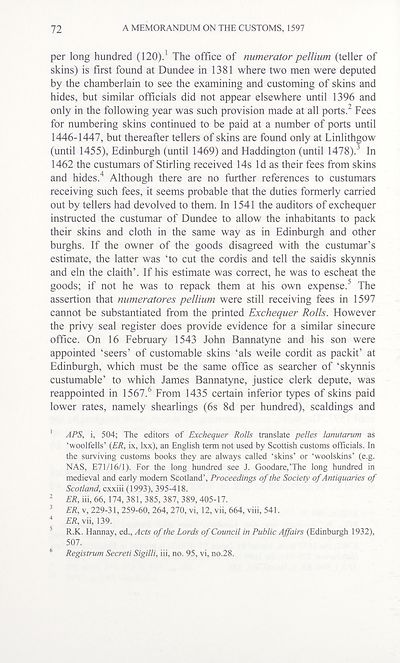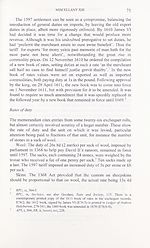Series 5 > Miscellany [of the Scottish History Society] XIII
(87) Page 72
Download files
Complete book:
Individual page:
Thumbnail gallery: Grid view | List view

72
A MEMORANDUM ON THE CUSTOMS, 1597
per long hundred (120).1 The office of numerator pellium (teller of
skins) is first found at Dundee in 1381 where two men were deputed
by the chamberlain to see the examining and customing of skins and
hides, but similar officials did not appear elsewhere until 1396 and
only in the following year was such provision made at all ports.2 Fees
for numbering skins continued to be paid at a number of ports until
1446-1447, but thereafter tellers of skins are found only at Linlithgow
(until 1455), Edinburgh (until 1469) and Haddington (until 1478).3 In
1462 the custumars of Stirling received 14s Id as their fees from skins
and hides.4 Although there are no further references to custumars
receiving such fees, it seems probable that the duties formerly carried
out by tellers had devolved to them. In 1541 the auditors of exchequer
instructed the custumar of Dundee to allow the inhabitants to pack
their skins and cloth in the same way as in Edinburgh and other
burghs. If the owner of the goods disagreed with the custumar’s
estimate, the latter was ‘to cut the cordis and tell the saidis skynnis
and eln the claith’. If his estimate was correct, he was to escheat the
goods; if not he was to repack them at his own expense.5 The
assertion that numeratores pellium were still receiving fees in 1597
cannot be substantiated from the printed Exchequer Rolls. However
the privy seal register does provide evidence for a similar sinecure
office. On 16 February 1543 John Bannatyne and his son were
appointed ‘seers’ of customable skins ‘als weile cordit as packit’ at
Edinburgh, which must be the same office as searcher of ‘skynnis
custumable’ to which James Bannatyne, justice clerk depute, was
reappointed in 1567.6 From 1435 certain inferior types of skins paid
lower rates, namely shearlings (6s 8d per hundred), scaldings and
1 APS, i, 504; The editors of Exchequer Rolls translate pelles lanutarum as
‘woolfells’ {ER, ix, Ixx), an English term not used by Scottish customs officials. In
the surviving customs books they are always called ‘skins’ or ‘woolskins’ (e.g.
NAS, E71/16/1). For the long hundred see J. Goodare.’The long hundred in
medieval and early modem Scotland’, Proceedings of the Society of Antiquaries of
Scotland, cxxiii (1993), 395-418.
2 ER, iii, 66, 174, 381, 385, 387, 389, 405-17.
3 ER, v, 229-31, 259-60, 264, 270, vi, 12, vii, 664, viii, 541.
4 ER, vii, 139.
5 R.K. Hannay, ed., Acts of the Lords of Council in Public Affairs (Edinburgh 1932),
507.
6 Registrant Secreti Sigilli, iii, no. 95, vi, no.28.
A MEMORANDUM ON THE CUSTOMS, 1597
per long hundred (120).1 The office of numerator pellium (teller of
skins) is first found at Dundee in 1381 where two men were deputed
by the chamberlain to see the examining and customing of skins and
hides, but similar officials did not appear elsewhere until 1396 and
only in the following year was such provision made at all ports.2 Fees
for numbering skins continued to be paid at a number of ports until
1446-1447, but thereafter tellers of skins are found only at Linlithgow
(until 1455), Edinburgh (until 1469) and Haddington (until 1478).3 In
1462 the custumars of Stirling received 14s Id as their fees from skins
and hides.4 Although there are no further references to custumars
receiving such fees, it seems probable that the duties formerly carried
out by tellers had devolved to them. In 1541 the auditors of exchequer
instructed the custumar of Dundee to allow the inhabitants to pack
their skins and cloth in the same way as in Edinburgh and other
burghs. If the owner of the goods disagreed with the custumar’s
estimate, the latter was ‘to cut the cordis and tell the saidis skynnis
and eln the claith’. If his estimate was correct, he was to escheat the
goods; if not he was to repack them at his own expense.5 The
assertion that numeratores pellium were still receiving fees in 1597
cannot be substantiated from the printed Exchequer Rolls. However
the privy seal register does provide evidence for a similar sinecure
office. On 16 February 1543 John Bannatyne and his son were
appointed ‘seers’ of customable skins ‘als weile cordit as packit’ at
Edinburgh, which must be the same office as searcher of ‘skynnis
custumable’ to which James Bannatyne, justice clerk depute, was
reappointed in 1567.6 From 1435 certain inferior types of skins paid
lower rates, namely shearlings (6s 8d per hundred), scaldings and
1 APS, i, 504; The editors of Exchequer Rolls translate pelles lanutarum as
‘woolfells’ {ER, ix, Ixx), an English term not used by Scottish customs officials. In
the surviving customs books they are always called ‘skins’ or ‘woolskins’ (e.g.
NAS, E71/16/1). For the long hundred see J. Goodare.’The long hundred in
medieval and early modem Scotland’, Proceedings of the Society of Antiquaries of
Scotland, cxxiii (1993), 395-418.
2 ER, iii, 66, 174, 381, 385, 387, 389, 405-17.
3 ER, v, 229-31, 259-60, 264, 270, vi, 12, vii, 664, viii, 541.
4 ER, vii, 139.
5 R.K. Hannay, ed., Acts of the Lords of Council in Public Affairs (Edinburgh 1932),
507.
6 Registrant Secreti Sigilli, iii, no. 95, vi, no.28.
Set display mode to:
![]() Universal Viewer |
Universal Viewer | ![]() Mirador |
Large image | Transcription
Mirador |
Large image | Transcription
Images and transcriptions on this page, including medium image downloads, may be used under the Creative Commons Attribution 4.0 International Licence unless otherwise stated. ![]()
| Scottish History Society volumes > Series 5 > Miscellany [of the Scottish History Society] XIII > (87) Page 72 |
|---|
| Permanent URL | https://digital.nls.uk/127314573 |
|---|
| Description | Over 180 volumes, published by the Scottish History Society, containing original sources on Scotland's history and people. With a wide range of subjects, the books collectively cover all periods from the 12th to 20th centuries, and reflect changing trends in Scottish history. Sources are accompanied by scholarly interpretation, references and bibliographies. Volumes are usually published annually, and more digitised volumes will be added as they become available. |
|---|


